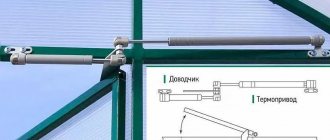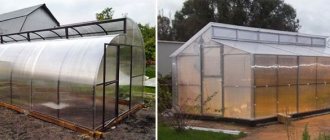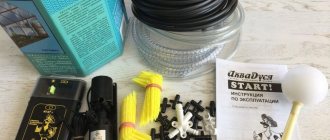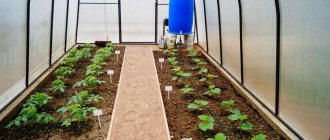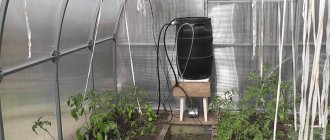Plants in the garden require moisture. It will be better if it is supplied to the roots constantly and in measured quantities. For this purpose there is a drip irrigation device. Difficulties with installing the system in the future eliminate heavy and ineffective physical labor. This can be judged by numerous reviews from gardeners. Many people are happy with this kind of liberation from hard manual labor. In addition to watering, there are many other things to do at the dacha. It is tempting to replace difficult and painstaking work with relaxation.
There are many types of devices and irrigation systems. They can be made or assembled with your own hands, or you can involve specialists.
Pros and cons of drip irrigation
Drip water supply has many advantages.
- The flow of water directly under the stem, which allows fertilizer to be applied simultaneously with moisture.
- Saving working time and physical effort for the summer resident. Having installed the system once, you can avoid manual watering throughout the entire season.
- Eliminating the possibility of soil drying out. Its humidity is always sufficient for the necessary plant growth.
- The system can be used for any plant because it is universal.
- Possibility of choosing the optimal option for irrigating beds.
Among the disadvantages, we can note the costs of the component parts of the drip irrigation device: fittings, hoses, tapes, dosing water pump, filter, etc. The system must be constantly monitored, dirt must be periodically removed, water flow checked, valve operation, etc. The installation is volatile and requires constant availability of electricity.
Advantages and disadvantages of such irrigation
Key advantages of the system:
- no obstacles to the flow of air to plant roots;
- active root propagation;
- better absorption of fertilizers;
- protection of the green part of plants from water ingress;
- minimizing labor costs;
- saving water and electricity.
Despite significant advantages, the system also has disadvantages:
- additional expenses for the purchase of equipment;
- the need for preliminary water purification using filters;
- regular system maintenance;
- time spent on installing the device.
Details are in this article.
Making drip irrigation with your own hands: where to start?
First, the drip irrigation scheme is drawn on paper, where all watering points, the location of the water source and containers are indicated. The spacing between rows of plantings is measured. Based on the finished dimensions, you can easily calculate the number of communications.
If a pump is installed, its location can be anywhere, but when watering by gravity, the container is installed closer to the plants.
Drip hoses or tapes are laid on the beds. They have built-in special droppers for supplying water to the plants.
Before assembling a drip irrigation system, it is necessary to have all the components for irrigation. If you have experience, it is advisable to choose them yourself, since watering kits are more expensive.
- A container of water – a barrel or tank.
- The main distribution manifold for water supply, from which it is supplied to the branches.
- Drip hose or tape.
- Valves connecting drip tapes to the collector.
It is not recommended to use metal containers, since corrosion leads to clogging of the system. If this cannot be avoided, the drip irrigation device must contain high-quality filtration.
Recommendations for using drip systems
There are time-tested recommendations for the use of drip pipelines that increase their efficiency.
- It is best to add fertilizers and bioadditives to the soil by dissolving them in water supplied through a drip system.
- Watering should begin 2 hours after sunrise, and end 2 hours before sunset.
- The optimal water temperature for irrigation is 20-23 degrees.
- You cannot immediately supply cold water after the supply of warm water has been exhausted.
- In a gravity system, the water tank should be at least 1 meter from the ground.
- It is necessary to ensure that the diameter of the wet spots around each dropper is uniform. Their increase or decrease may indicate, respectively, a rupture or clogging of the pipeline.
If it is impossible to water during the day, it is recommended to give the plants 2/3 of the daily water requirement in the morning, and 1/3 in the evening.
In greenhouses, it is better to place the storage tank indoors - there it heats up faster and maintains the water temperature longer
Proper watering saves water and guarantees a high yield and beautiful lawn.
Drip hoses
Hoses are sold in coils. Their feature is the supply of the same amount of water throughout the entire bed, even if the terrain is uneven. The maximum irrigation length is selected so that the unevenness at the beginning and end of the hose does not exceed 10-15%. For one season, it is enough to use tapes with a wall thickness of 0.1 to 0.3 mm for drip irrigation of the garden. They are laid only on top.
Thick-walled (up to 0.8 mm) will last 3-4 seasons. They can also be used for underground installation. The diameter of the tapes is 12-22 mm (common size is 16 mm). Hard tubes last up to 10 seasons. Their diameter is 14-25 mm.
Through one dropper the water consumption is:
- hose - 0.6-8 l/h;
- thin-walled tape – 0.25-2.9 l/h;
- thick-walled tape – 2-8 l/h.
To regulate the flow, a tap for drip irrigation is connected to the hose or drip tape.
On average, you need to take 1 liter of water per day per plant, 5 liters per bush, 10 liters per tree. The data is indicative, but is suitable for determining the total consumption. To be more precise, when drip irrigation is performed, 1 tomato bush requires 1.5 liters, cucumbers - 2 liters, potatoes and cabbage - 2.5 liters. 20-25% of the reserve is added to the result obtained and the required tank volume is determined.
The distance between the drippers depends on the frequency of planting and can be from 10 to 100 cm. Each of them has one or two outlets. The consumption may remain the same, but in the latter case the depth decreases and the irrigation area increases. Dropper spiders are installed on a bed in 4 rows with the distribution of up to 4 plants.
Where and at what cost can I buy it?
You can purchase it on the company's official website. Also, the company's managers actively cooperate with other representatives - wholesale stores, where they offer their products.
They most actively cooperate with stores:
- Auchan-garden,
- Magnet,
- Castorama,
- Leroy Merlin.
The pricing policy for goods in representative stores may differ and on average, depending on the chosen option, is 1200-2300 rubles.
Droppers
Droppers can be installed on plastic pipes. They are produced in several types:
- with fixed water flow;
- adjustable - with manual adjustment of irrigation intensity;
- uncompensated - the intensity of water supply decreases towards the end of the bed;
- compensated - with a membrane and a special valve, creating a constant pressure during pressure fluctuations in the water supply;
- “spider” type - with distribution to several plants.
External droppers are inserted into a plastic pipe, in which holes are pierced with an awl.
How to make a CP in a greenhouse and at the dacha with your own hands
Creating drip irrigation in a small greenhouse or suburban area is difficult. But before you do drip irrigation, it is important to correctly select all the components. For watering systems in small garden plots, the best solution would be to purchase an inexpensive kit. Today they are produced in many different types. You can water a bed 50 - 100 m long with even the simplest kit.
Important! If the set does not include filters, you must purchase them in addition, otherwise the system will quickly become clogged.
When the plot or greenhouse is larger, all components will have to be selected taking into account the planting plan and their requirements for humidity, soil type, and method of water supply.
Installation of drip irrigation at the dacha Source images.ua.prom.st
Purpose of fittings
The system can be simply assembled using special fittings for drip irrigation.
- Start connectors for connecting drip tape to plastic water pipes. They are made with a rubber seal or a clamping nut. Holes are drilled in the HDPE pipe using a wood drill with a centering spike and start connectors are tightly inserted with or without taps. Regulation of water consumption is required if certain zones consume it less than others or for alternate watering of different areas.
- Drip irrigation fittings, angled or in the form of tees, are used to connect the tape to a flexible garden hose. They are also used for branching or turning. The fitting seats are made in the form of ruffs, which ensures tight fastening of the tubes.
- The repair fitting is used in case of a break or to extend the drip tape. With its help, its ends are connected.
- The plug is installed at the ends of the drip tape.
Individual parts
The manufacturer offers not only ready-made irrigation systems, but also additional elements for them.
Fitting:
- connections made of plastic and brass,
- tees,
- adapters and bends,
- nipples,
- fittings,
- couplings and tips.
Rubber hoses for:
- pond,
- pressure,
- microporous and splashing types,
- made of 2-5 layers.
You can also purchase accessories for connecting the pumping system - filters, tips, fittings, clamps and hoses.
Installation of an irrigation system made of thin-walled tapes
Distributing polyethylene pipes with a diameter of 4 cm are connected to the garden water supply. This diameter is best suited for installing a start connector - a special tap for drip irrigation, which is used to connect a perforated drip tape to the pipe.
It is manufactured with a small thickness and assembled using reinforcement. The holes are made at equal intervals. The drip tape is put on the tap with tension, and then additionally secured with a plastic nut. The ends of the sleeves are closed with plugs, sealed or tucked.
The disadvantage is the low strength of the tape material, which is easily damaged by rodents and insects. In terms of other indicators, the system shows itself only on the positive side.
What does the industry offer?
Industrial equipment for drip irrigation is offered on the Internet and in stores for gardeners. It includes all the necessary components to create a complete irrigation system. Such sets are often represented by the following components:
- main tubes of a certain diameter;
- drip tape;
- various tees for the tube and for transition from tube to tape;
- plugs for tape and tube;
- corners for the tube;
- tube connectors;
- tube pass-through valves;
- various adapters;
- clamping needles for the tube.
And, of course, all industrial kits come with detailed instructions for assembling, installing and using the watering system.
Installation of a system with tubes and built-in droppers
The system is highly durable and significantly longer lasting. It consists of a hose in which cylindrical droppers are built at regular intervals. The tube can be placed on the soil surface, mounted on stands, suspended on a wire, or buried in the ground.
Water under pressure disperses from the container throughout the system and is smoothly distributed, coming from small holes. It is important that the tank is located at a height of 1-1.5 m from the ground surface. The gardener is only required to fill it in a timely manner, after which the liquid flows to the plants under the influence of gravity.
How to water cucumbers?
In industrial systems, drip irrigation of cucumbers is carried out with water supplied to each plant. The depth of the roots is 15-20 cm and tensiometers are installed there to control humidity. For gardeners, improvised means made from plastic bottles are suitable. They are installed on the bottom or with a closed plug in the ground. The top should be open to fill with water.
- First way. The dropper is made from a used ballpoint pen refill. It is washed with a solvent to remove any remaining paste and plugged at the end with a match. A puncture is made at the end half the thickness of the rod. A homemade dropper is inserted into a puncture made from the bottom of the bottle at a height of 15-20 cm. Then the containers are filled with water and placed near the bushes so that the moisture gets to the root.
- Second way. Holes are made in the bottle along the entire height, departing 3-5 cm from the bottom. Then it is buried bottom down to a depth of 20 cm. The cork is unscrewed and the container is filled with water through the top. The bottle can be buried upside down, having previously cut off the bottom, through which it is convenient to fill it with water in the future. To prevent the holes from becoming clogged with soil, the outside of the bottles is wrapped with needle-punched fabric, which is used as a covering material for greenhouses.
- Third way. Bottles filled with water can be suspended above the ground by punching holes in the lid.
Bottle drip irrigation of cucumbers is convenient due to its cost-effectiveness, since there is no need to spend money on materials. The disadvantage is the difficulty of installation over large areas. The process of filling with water is troublesome, and the holes are often clogged with soil. Despite this, you can be convinced of the advantages of the drip method. Reviews indicate that it is quite effective in small greenhouses.
It is more convenient to fully water cucumbers in large greenhouses through a centralized system with branded drippers.
System elements
Installation of drip irrigation does not present any great difficulties. This work does not require any special knowledge or skills.
But before installation, you should decide what you need to buy for drip irrigation, and which manufacturer to give preference to.
It is also recommended to draw up a plan of the summer cottage and mark on the diagram the location of the system. In this case, you need to take into account the location of trees and beds.
In fact, the range for drip irrigation is very wide and is represented by various parts from different manufacturers. When choosing, you should not chase the low price. Because the quality of cheap products cannot be high. It is better to adhere to the optimal ratio of cost and quality. It should also be noted that today well-equipped drip irrigation kits are available for sale. This saves the summer resident from the need to select individual parts. Below are the materials needed to set up a drip irrigation system.
Dropper: its types and functions
There can be two types: drip tapes and single devices. Drip tape is a hose with a large number of holes. There are special systems inside that regulate the water output. Depending on the principle of operation, there are three types: labyrinth, slot, emitter. Each of the varieties has its positive and negative sides. Most summer residents prefer emitter tapes. Because they are more technologically advanced and durable.
But before you buy an emitter tape for drip irrigation, you need to remember that it is most convenient to lay the tapes on beds with vegetable crops. But single devices or drippers are more suitable for watering free-standing perennial crops, shrubs, and trees. These units are also divided into two types: without pressure compensation and with compensation. Drippers can be used, for example, for watering currant bushes. You can read in detail about high-quality and timely care of currants in addition to watering here.
The main difference between a drip tube and a tape is the wall thickness and longer service life. The tube can serve properly for 3 years or more. Also, the tube, unlike the tape, can be buried in the ground. This does not change its functionality. Therefore, many people decide to buy a drip tube for irrigation, because it has excellent performance characteristics.
Many novice summer residents are wondering where to get drippers for drip irrigation and how much they cost. You can purchase these system elements at any specialized store or order them on the Internet.
To extend the life of the tube, it is advisable to install a filter. Otherwise, the dropper may quickly become clogged and stop performing its task. The cost of the dropper is low. But if you purchase a drip irrigation tube in bulk, many companies make a discount and in the end the product comes out even cheaper.
Tee - an important detail
Without this part, productive operation of the system is impossible. Using a tee, you can organize watering in several areas simultaneously. Therefore, a tee for drip irrigation is an important element and it is advisable to install it immediately.
Soft watering hose or ready-made hose
If you use a soft watering hose on one side, it will need to be plugged. The cost of this part is low. You can buy a drip irrigation hose at any specialty store.
Controller: types and applications
It is the main part of any automatic irrigation system. It determines the operating time of the valve and ensures regular watering. It looks like a small box with a display and several switches. The controller receives information from wind, humidity, and temperature sensors. Most models work from the network. True, there are also devices with a battery. They are more convenient to use.
If you buy an automatic controller for drip irrigation, the efficiency of the entire system will increase significantly. Semiconductor and hybrid controllers are available for sale. Semiconductor devices are installed indoors. Used to control irrigation in small areas. Most often for irrigating lawns and lawns near houses.
Hybrid models are more reliable and modern. Allows you to save energy and water. Equipped with a microprocessor that controls the valves one by one. Such units are mainly used to organize watering of large areas and greenhouses.
Drip irrigation injector
This element allows you to increase productivity, reduces the labor intensity of irrigation, eliminates contamination of groundwater and soil, and allows water to instantly reach the roots of crops along with mineral fertilizers. But you need to know how to choose the right injector for drip irrigation, since it costs a lot. You should choose a device based on your specific situation, after consulting with a specialist.
Other system elements
Also, to install a drip irrigation system you will need a pump, fitting, taps, adapters and plugs. Most often, difficulties when choosing parts for organizing drip irrigation arise with hoses. Because they can be of different types. And many summer residents do not know which supply hoses for drip irrigation are best to use.
When choosing, you should be guided by where the system will be located: on the surface or under the ground. On sale you can find a oozing hose. It is used for laying underground. Made of PVC, has a microporous structure. Performs the function of moistening the soil around the crop. Ideal for caring for tomatoes, which do not like moisture getting on their leaves.
The sprinkler is used for watering flower beds, beds, and lawns. The maximum hose length is 22 m. But if necessary, the length can be increased. The unit is equipped with fittings for more efficient irrigation. Tape hose is the most expensive. Its advantage is that it can be used in conjunction with electrical engineering.
Knowing how to install drip irrigation, you can organize an effective irrigation system for crops.
Installation is simple. First, the pipework is laid. After this, install the filter and pump. Then the controller and, if necessary, a unit for applying fertilizers are installed. Next, drip tapes are laid out under the trees and in the beds. The tapes are connected to the main pipes.
Drip irrigation devices: automatic
Automatic watering requires funds for equipment, but as a result, a lot of time will be saved and the harvest will compensate for the costs. The most important component of the system is the controller or timer, which does not require human intervention. The latter specifies only the frequency and duration of irrigation. The timer can be electromechanical or electrical. The controller can set an irrigation program, which takes into account the pressure in the system, sets daily watering cycles and takes into account humidity and temperature.
For simple systems, the drip irrigation scheme requires a single-channel device, but in a complex scheme, the number of channels may be required. Judging by the reviews, experienced gardeners prefer to use several simple timers that work according to separate programs.
In order not to depend on the energy source, it is advisable to purchase devices that run on several AA batteries.
Automatic drip irrigation from a water supply often requires a pump. Its power must correspond to consumption. The mechanism should be simple, not very noisy and resistant to chemical compounds, which are often used in the system as fertilizers.
Irrigation dosing
In order to more accurately dose the amount of water, use a soil moisture sensor for drip irrigation, which measures the actual soil moisture. When there is sufficient humidity, watering is either reduced or stopped altogether.
Thanks to the humidity sensor, you can avoid waterlogging of the soil and save water consumption.
There are a sufficient number of irrigation systems on the modern market. For example, drip irrigation Agroplast, which offers almost everything you need to set up a drip irrigation system.




